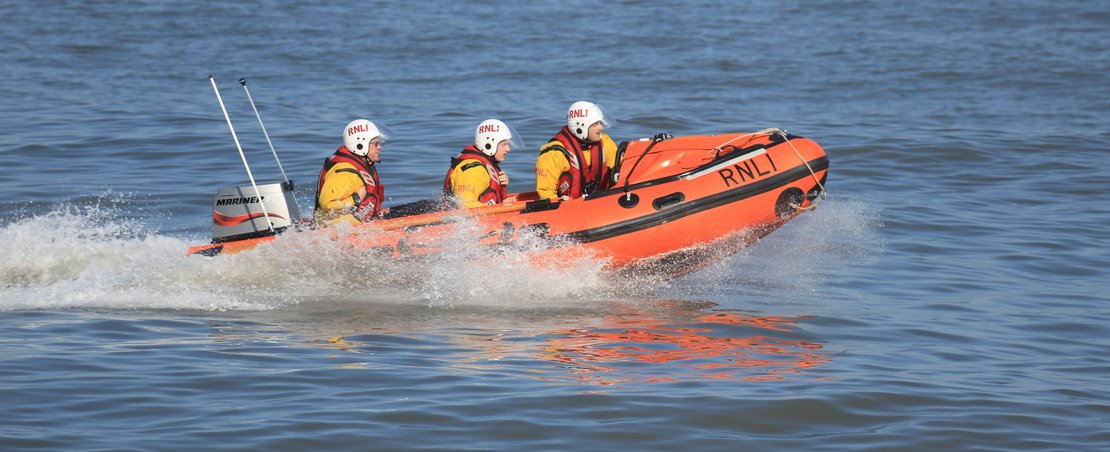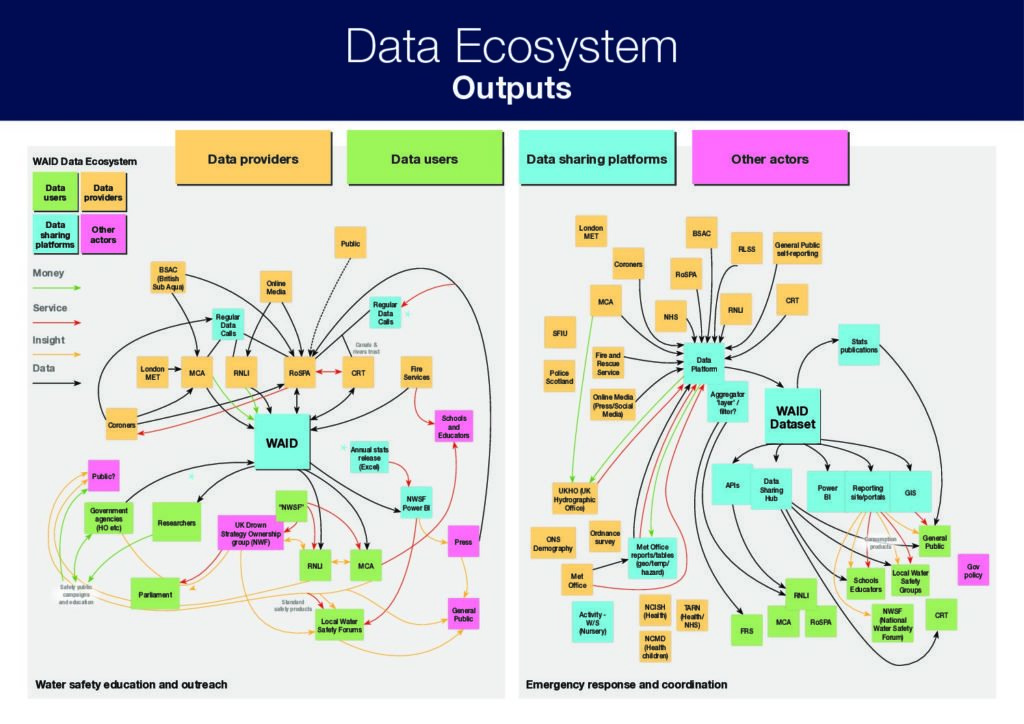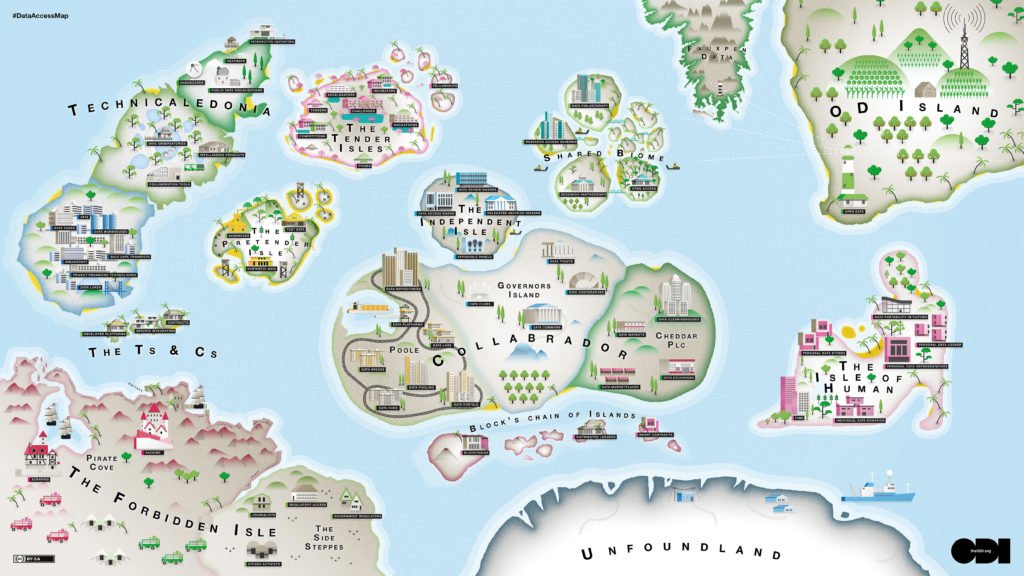
This is part of a series of case studies on the value of data collaboration that we are producing as part of our partnership with Microsoft.
Introduction
The WAter Incident Database (WAID) is a service developed by the National Water Safety Forum (NWSF) to bring together water-related incident data from a wide range of sources within the UK. It acts as a single taxonomy and repository for fatal water incidents.
Its key aims are to:
- Provide evidence for targeted drowning prevention activities to decrease drowning related fatalities.
- provide insights into levels of risk, enabling meaningful comparisons with activities outside the water sector, and the determination of risk acceptability;
- replace and improve upon the uncoordinated efforts of organisations trying to establish national trends based on limited data of uncertain quality;
- produce much higher-quality evidence;
- maximise value and minimise aggregate cost of data collection.
The database in its current form is being descoped, therefore the WAID team are currently developing a new, improved iteration which accompanies a shift in priorities for the use of data to save lives.
Collective vision and collaborating with data
The NWSF, legally housed within the Royal Society for the Prevention of Accidents (RoSPA), was first set up in 2004 with the aim of diversifying opinions within existing networks and increasing collaboration. There is no single organisation with the sole responsibility for the response to and prevention of water related incidents, but it is the collective aim of the NWSF to realise a future without drowning, and to reduce water related incidents and harm in the UK.
In 2009, the NWSF set up WAID – a database of water-related incident data – to help support the prediction and prevention of water-related incidents, and to monitor progress against it’s goals of reducing accidental drowning fatalities in the UK by 50% by 2026 and reducing risk among the highest-risk populations, groups and communities.
The WAID development team consists of members from the Maritime and Coastguard Agency, the Royal Life Saving Society UK (RLSS UK), the National Fire Chiefs Council (NFCC), the Royal National Lifeboat Institution (RNLI), the Royal Society for the Prevention of Accidents (RoSPA), Microsoft, Co-operative Web and the Open Data Institute (ODI).
Within the NWSF, 15 CEOs from network organisations work together to further the WAID project. Having senior leadership, such as CEOs, this close to the data sharing project ensures top-down buy-in and accountability. Financial support for the project, in addition to the resources provided by the organisations within the WAID development team, is also provided by Trinity House.
Mapping the data landscape
How WAID works
Currently WAID is an online system designed to accept data from a wide range of data sources, either through direct entry via the web, or bulk upload. The system builds upon a number of existing sources of data, such as coroners' reports and search and rescue reports.
Where is the data from? Source: WAID Annual Report 2020
- WAID is web-based and collects incident data from a wide range of sources including the emergency services, sports governing bodies, coastguard, rescue services, coroners courts, media reports etc.
- Collected data is merged into a single incident record for each incident to produce a comprehensive account from basic date/location/casualty information, root causes and emergency responses, to investigation outcomes. Incident records are continually updated as further information becomes available, for example from investigation reports or new data sources.

Developing a new system
The original WAID system brought the benefits of standardised data and a taxonomy of categories for data collection. Collaboration allowed the team to take a step back regarding the data they were collecting, and focus on standardising for the outputs they wanted to create. By mapping the datasets and data fields that were needed to the ones that were being provided, it allowed the team to think critically about that data they actually needed, so that they minimised collecting unnecessary data, and worked together to source missing data that was needed for their outputs.
However – despite the successes of the original system in simplifying the data collection process – the current system is in need of evolution.
The current approach for managing information about non-fatal incidents is manual, retrospective, and the multi-organisational nature of managing incidents leads to potential inaccuracies in the dataset. External audits on technical debt and security showed that this was a declining system, as the software costs were increasing. Further, the user experience (UX) and customer journey was dated and not fulfilling user needs. In order to increase usability, the team were using technical workarounds, but these adaptations were starting to outpace the core functionality and require too much upkeep to be an efficient use of resources.
Following a discovery research phase two years ago, it was decided that WAID would invest in the development of a brand new system.
The new approach
The WAID team developed a proof of concept for the new system which allowed the team to visually pitch to the CEO board, and helped to communicate the challenges ahead in governance and what they needed the board to do. Being able to demonstrate the value of the new WAID system has meant that both the WAID development group and the CEO board see it as a collective problem to solve rather than one of any particular organisation.
The new WAID platform utilises Microsoft’s Azure Cloud Services, and has allowed the team to develop an architecture that can be scaled in the future – and is flexible for future technological developments. It is anticipated that the new system will go live over the next 12 months.
The new system will embody WAID’s beliefs in openness and the desire to make data as open as possible. It will encompass data from across the data spectrum, facilitating an increase in velocity and shared insight from data. This openness means that the system is also set up for future advancements, for example to encourage predictive analytics based on the data. Ultimately this will bring more value to the network.
The new data model will also offer more advanced analytical uses. Previously, much of the insight and cutting-edge work had to be done in silos outside of the core system. Instead, the new system will enable NWSF members with more developed analytical capabilities to support the other members to develop collaborative use cases. It will also allow external users to analyse the data within the WAID environment using the latest data science tools and technologies, enabling research by academia and third parties.
Data ethics will also be a fundamental consideration. The data included in the WAID platform has the potential to be about sensitive incidents – such as accidental drownings and suicide – therefore it is paramount to ensure that the data on the platform is ethical. Before they’re shared on the WAID platform, all datasets will undergo a data ethics review to ensure sharing follows the new ethical guidance. An open-as-possible approach should streamline the review process, allowing more time for the review of ad-hoc requests for additional datasets or to use the data in unexpected ways. The new system will allow a more structured security model where access can be granted to this information where there is a relevant use case in place.
There is also ongoing work to build trust. The initial proof of concept allowed the WAID team to get a better understanding of what data was being captured by each organisation and the requirements for that data to be used.
The long-term vision is to use aggregate data to analyse trends and use predictive analytics in order to predict and therefore prevent risks. For example, weather data from the Met Office could be combined with data from locations with high water incident rates to specifically identify risks of cold water shock – allowing local resources to focus on smaller geographical areas and ultimately reducing the risk of loss of life.
Building a partnership: support from outside
In developing its new system, WAID sought advice from Microsoft and the ODI, centred on using research and tools to better understand the WAID offering. Microsoft has provided technical expertise in order to maximise the value from the Azure platform, while the ODI delivered expert advice through a series of workshops and specific guidance.
For example, the WAID team joined an ODI Data Ecosystem Mapping workshop to imagine what the future open and collaborative ecosystem of WAID could be, what kind of value could be delivered to stakeholders, and what kind of data infrastructure could support it. An ODI Data Ethics Canvas workshop helped the WAID team think through the ethical issues around the collection, processing and use of this data.
The ODI also gave feedback on the data governance aspects of the data sharing framework. As a result, the WAID team created data governance principles that all partner organisations have subsequently signed up to. Engagement with the ODI’s protected characteristics research inspired the team to reach out to the Black Swimming Association (BSA) to better diversify the potential data sources and uses in the future.
There is a desire for the new system to enable greater participation from a broader range of stakeholders. The WAID team is keen for the future system to be better linked with other organisations, for example divers’ organisations who collect lots of data on water conditions. The use of ODI tools and Microsoft experience has helped WAID to further open up the ecosystem.
The following table maps the ODI’s six manifesto points against key elements identified in the case study
[table id=75 /]
Conclusion/next steps
With a new system in place for collecting, analysing and sharing data, new governance models will also need to be put in place. For example, they will explore structures such as data institutions and data co-ops, as well as more traditional private company models to structure their organisation. Many of these potential models are included on the ODI’s Data Access Map which showcases the different models organisations can utilise to access or share data.
